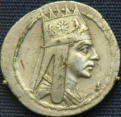



The Armenians of Jerusalem form four distinctive groups, each as
vibrant as the rest, yet all united by their common heritage and
their incontestable belief in a shared heritage. The language, too,
is always the same.
That is not to deny the nascent undercurrent of healthy rivalry that each harbors. The two major groupings are the native "kaghakatsis" who live mainly in the Armenian Quarter of the Old City, and whose ancestors first settled in the region 2,000 years ago, and the "Vanketsis" who live within the precinct of the Convent of St James where they had found refuge from the Turkish genocides and pogroms. On the cultural level, the Kaghakatsis congregate around their Jerusalem Armenian Benevolent Union, the JABU, while the Vanketsis have split their activities into two avenues of expression, each driven by a varying ideology. The "Homentmen" (allied with the Tashnag political party) pined for an independent Armenia, free of Soviet influence and intervention, while the "Hoyetchmen" had been comfortable with the status quo in Armenia (prior to Gorbachev's coup). Another minor splinter group, the "Ramgavar," was more or less tenuously sympathetic to the Soviet line. There are two other groupings, the Catholic and Protestant Armenians, mostly converts. The Catholics have set up their own private youth club, "Arax" (after a popular river in Armenia). In recent years, the lines of demarcation among the groupings has begun to dissolve, in the face of modern challenges. Rivalries have melted away and closer relationships established: the younger generation has no patience with stultified stances, and with the inception of social networking, they are more attuned to a more global outlook. The youth clubs have their own scout groups and cultural programs. Among these, thespian aspirations rank high. Among their more ambitious efforts, have been the staging of classics like "Salome" and Bedros Tourian's "Sev Hogher" (Black Earth), but comedy sketches and one-man stands have been the main fare on the dramatic menu. World famous musician Ohan Dourian has often regaled audiences with his piano renditions, while Tavit Tavitian offered audiences his version of Czardas. Over the centuries, the kaghakatsi have enriched the Holy City's multifaceted ethnic and social fabric with a proliferation of talent, vision and hard work, creating a unique culture and identity, unlike any other in the Armenian diaspora. This tiny enclave whose members have been making their home in the cobblestoned alleys of the Old City for centuries for over 2,000 years, have given the city its first printing press and photographic studio, and titillated the palates of aficionados with spicy blends of their irresistible cuisine. The kaghakatsi ancestors were great teachers, artists, goldsmiths, carpenters, story-tellers and family men, but they were poor record keepers. Except for a register of births, deaths and certificates maintained by the Armenian Patriarchate of St James in Jerusalem, and some family heirlooms, we possess no archives or documents detailing their way of life, other than word-of-mouth accounts. True, little has changed in the Old City over the centuries, but memories also dim, and the next generation of kaghakatsis may wonder where on earth they came from: who were the kaghakatsis, what made them run? A "Family Tree Project" launched a few years ago, now part of the expanded endeavour that will encompass all Armenians of Jerusalem, seeks to answer these questions, its mandate preserving the history, culture and traditions of the kaghakatsis who at their peak numbered over 25,000. As part of the project, efforts are being made to trace the family connections of this unique entity whose members are all related to one another, in one long unbroken chain. The project will ensure that their unique place in the history of the immortal city of Jerusalem, is not irretrievably lost. The Family Tree is accessible only to bona fide kaghakatsis with the help of a private key available here. The Family Tree Project has so far collated genealogical details of over 3000 kaghakatsi Armenians from among the members of the score of leading “clans,” relying mostly on personal reminiscences and recollections. But the years may have shrouded some of these in obscurity. While the project pays tribute to the memory of those who have gone before us, it hopes to bequeath to future generations of kaghakatsis a deeper sense of belonging to a uniquely cohesive society that knows well the meaning of sharing and caring. For wherever there is a kaghakatsi in any part of this world, there is a Jerusalem and an Armenia.
Armenian Jerusalem























